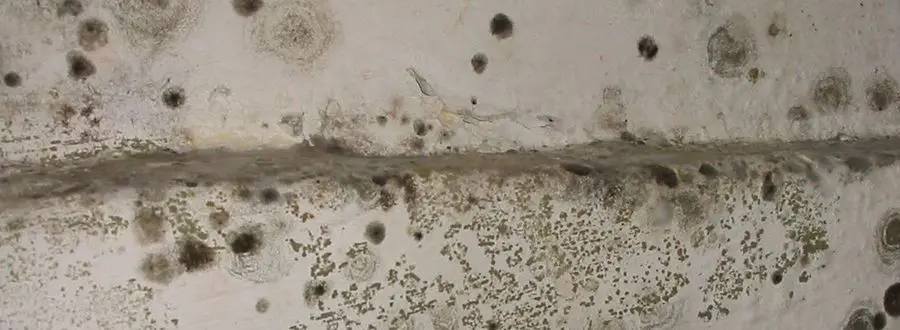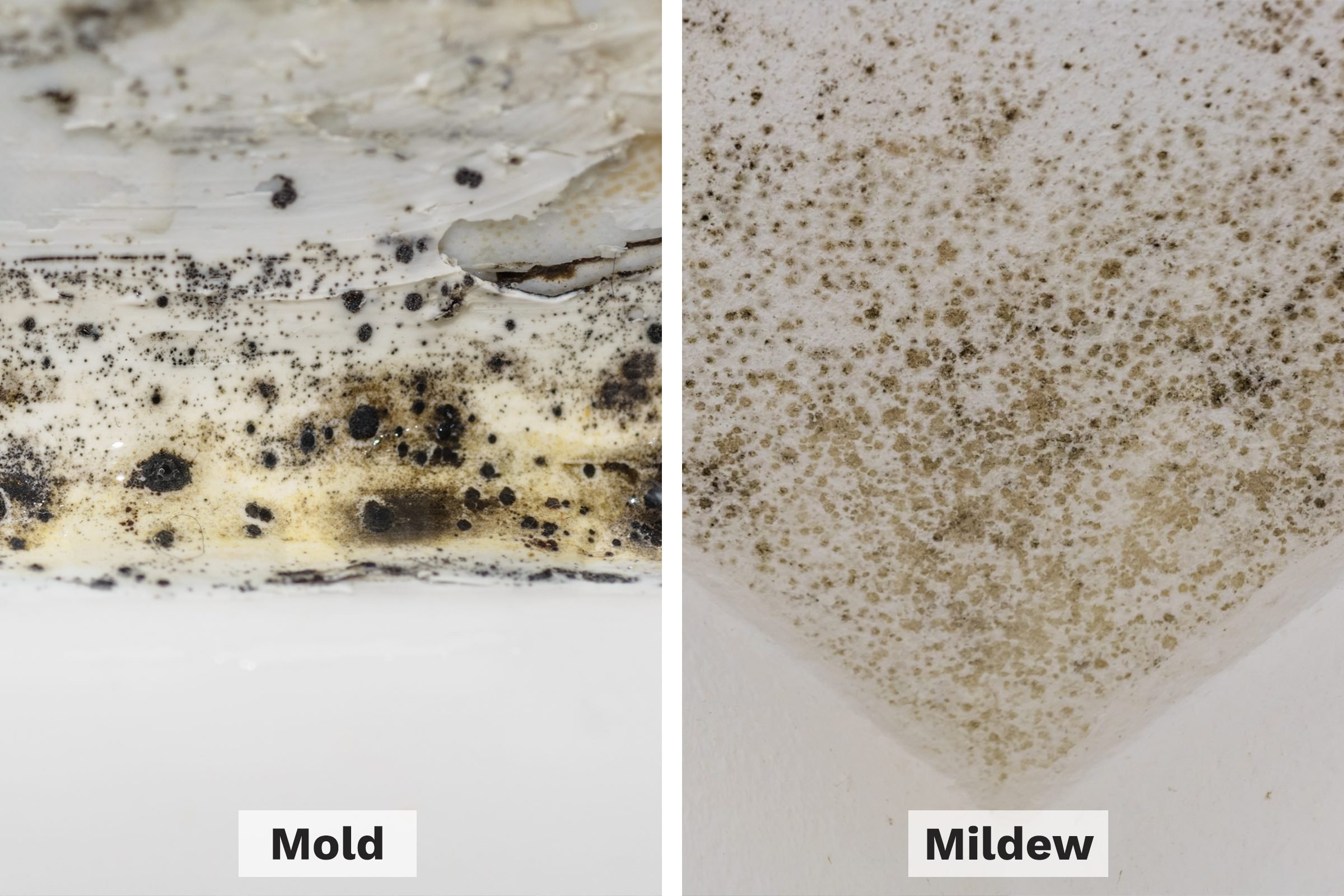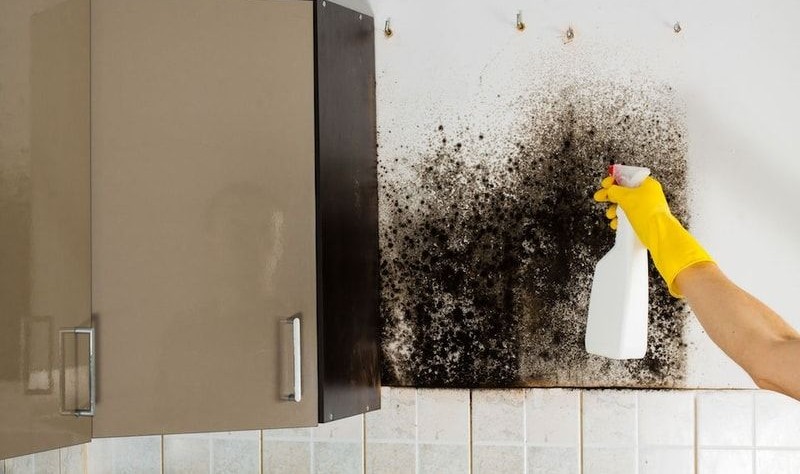
What Does Black Mold Look Like on Walls?
Black mold on walls often appears as dark, black, or greenish-black spots or patches. It can grow in a variety of patterns, including small clusters or large areas of growth. Here are some key characteristics to help you identify black mold:
1. Color
The most distinguishing feature of black mold is its color. True black mold is usually dark black or greenish-black, although it can sometimes appear as dark brown or gray. Unlike other types of mold, such as Aspergillus or Penicillium, which may be lighter in color, black mold tends to be much darker and more concentrated.
2. Texture
Black mold can have a slimy, wet texture when it’s actively growing due to the moisture it feeds on. As it dries out, it may become powdery or flaky. If you touch the mold (which is not recommended without protective gear), you may notice a slimy or damp feeling. Be sure to avoid disturbing the mold, as this can release spores into the air, which can spread the mold and pose health risks.
3. Shape and Pattern
Black mold typically grows in irregular patterns, spreading outward from the point of moisture. You may notice it spreading along baseboards, in corners, or near windows. It often appears in spots or patches and can cover large areas of walls, especially if left untreated. These patches may have fuzzy edges or blend into the surrounding surface, making them harder to spot at first.

4. Musty Odor
In addition to its appearance, black mold is often accompanied by a strong, musty odor. This smell is caused by the volatile organic compounds (VOCs) released by mold as it grows and reproduces. The musty smell is a clear indication that there is mold present, even if you can’t see it right away.
For more detailed information on black mold and how it grows, visit the EPA’s guide on mold and health.
Where Is Black Mold Commonly Found on Walls?
Black mold tends to grow in areas that are consistently damp or where water damage has occurred. Here are some common locations on walls where you might find black mold:
1. Bathrooms
Bathrooms are one of the most common areas for black mold to grow, particularly on walls near showers, tubs, or sinks. The high humidity and frequent water use create the perfect environment for mold to thrive. If your bathroom doesn’t have proper ventilation, mold growth is more likely to occur.
2. Basements and Crawl Spaces
Basements and crawl spaces are often damp and poorly ventilated, making them prime locations for black mold. Leaking pipes, poor drainage, or moisture from the ground can lead to mold growth on the walls, floors, or ceilings of these spaces.
3. Around Windows and Doors
Windows and doors can be entry points for moisture, especially if they are not properly sealed. Condensation on windows or water leaks can create the ideal conditions for black mold to form along window frames or doorways.

4. Behind Wallpaper or Paneling
Mold often grows in hidden areas behind wallpaper, paneling, or drywall where moisture gets trapped. If you notice any bubbling, peeling, or discoloration of wallpaper, it’s worth investigating to see if mold is growing underneath.
For more tips on mold prevention and where to look for mold in your home, check out This Old House’s guide to mold prevention.
How to Remove Black Mold From Walls
Once you’ve identified black mold on your walls, it’s crucial to remove it quickly to prevent it from spreading and causing further damage. However, removing black mold can be dangerous, so it’s important to take the right precautions. Here’s how to remove black mold safely:
| Step | Description |
|---|---|
| 1. Protect Yourself | Before attempting to remove black mold, make sure to wear protective gear, including gloves, goggles, and an N-95 respirator mask to avoid inhaling mold spores. You should also cover exposed skin and wear old clothing that can be easily washed or discarded. |
| 2. Ventilate the Area | Open windows and doors to allow fresh air into the room and use fans to improve air circulation. This will help reduce the concentration of mold spores in the air while you work. |
| 3. Use a Mold Removal Solution | Mix a solution of one part bleach to three parts water or use a commercial mold remover. Spray the solution directly onto the moldy area and allow it to sit for 10-15 minutes. Bleach kills mold spores and disinfects the surface. |
| 4. Scrub the Mold | After the solution has had time to soak in, use a stiff brush to scrub the mold off the wall. Be thorough, but try to avoid damaging the wall’s surface. After scrubbing, wipe the area down with a clean, damp cloth to remove any remaining mold or cleaning solution. |
| 5. Dry the Area Completely | Once the mold is removed, use fans and dehumidifiers to dry the area completely. Mold thrives in damp environments, so ensuring the area is dry will help prevent the mold from returning. |
| 6. Repaint or Restore (If Necessary) | If the mold has caused discoloration or damage to your walls, you may need to repaint or restore the affected area. Be sure to use mold-resistant paint or primer for added protection against future mold growth. |
For more severe cases of black mold, or if the mold has spread behind walls or into structural components of your home, it’s best to hire a professional mold remediation company like Citywide Mold Mitigation to ensure the mold is safely removed and the affected area is restored.

When to Call a Professional Mold Remediation Company
While it’s possible to remove small areas of mold on your own, larger infestations should always be handled by professionals. Here are some signs that it’s time to call a mold remediation expert:
- Extensive mold growth: If the mold covers an area larger than 10 square feet, professional remediation is recommended.
- Mold in hidden areas: Mold growing behind walls, under floors, or in HVAC systems requires specialized equipment to remove.
- Health concerns: If you or your family are experiencing respiratory problems, headaches, or allergic reactions, it’s important to have the mold removed professionally to avoid further exposure.
- Water damage: If the mold is a result of water damage, professionals can not only remove the mold but also address the source of the moisture.
If you’re dealing with black mold on your walls, Citywide Mold Mitigation offers expert mold inspection, removal, and remediation services to help keep your home safe and mold-free. Contact us today to schedule a consultation.
FAQ
| Question | Answer |
|---|---|
| What does black mold look like? | Black mold appears as dark, black, or greenish-black spots or patches on walls, ceilings, or other surfaces. It often has a slimy or wet texture when growing and can spread in irregular patterns. |
| Is black mold dangerous? | Yes, black mold can be dangerous, especially to people with respiratory issues, allergies, or weakened immune systems. Long-term exposure can cause health problems, including coughing, sneezing, headaches, and more serious respiratory conditions. |
| Can I remove black mold myself? | For small areas of mold (less than 10 square feet), you can attempt to remove black mold yourself using a bleach solution or commercial mold remover. However, larger infestations or mold in hidden areas should be handled by professionals. |
| How can I prevent black mold from returning? | To prevent black mold from returning, address the source of moisture that allowed it to grow. This may involve fixing leaks, improving ventilation, or using dehumidifiers to keep humidity levels low in your home. |
| When should I call a mold remediation professional? | If you’re dealing with extensive mold growth, hidden mold, or mold-related health issues, it’s best to call a mold remediation professional like Citywide Mold Mitigation to ensure safe removal and prevention of future growth. |
If you suspect black mold in your home, contact Citywide Mold Mitigation today for expert mold removal and prevention services.

